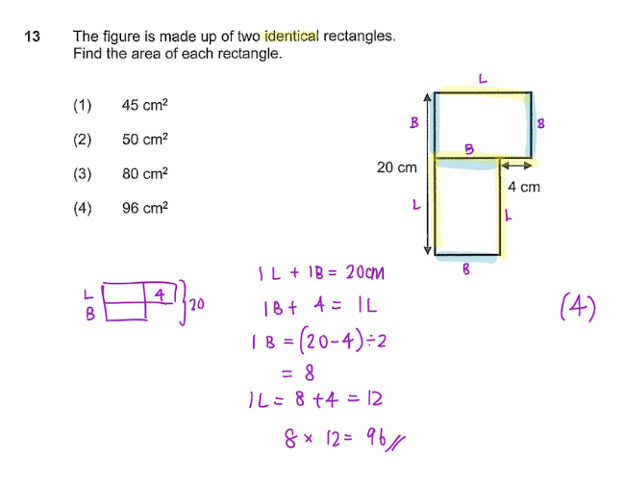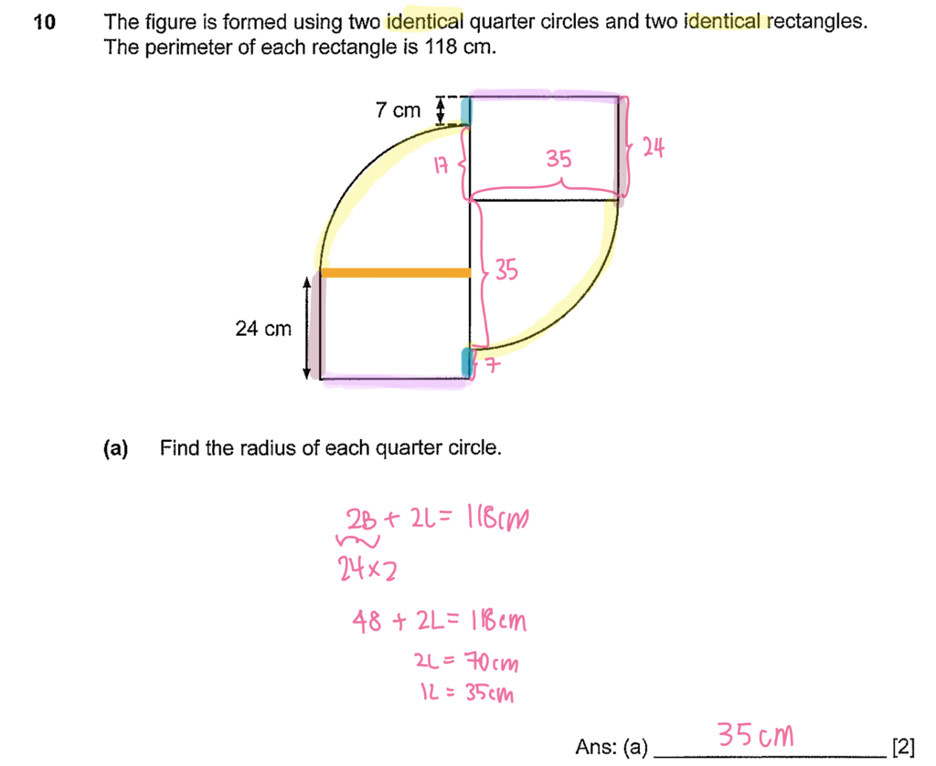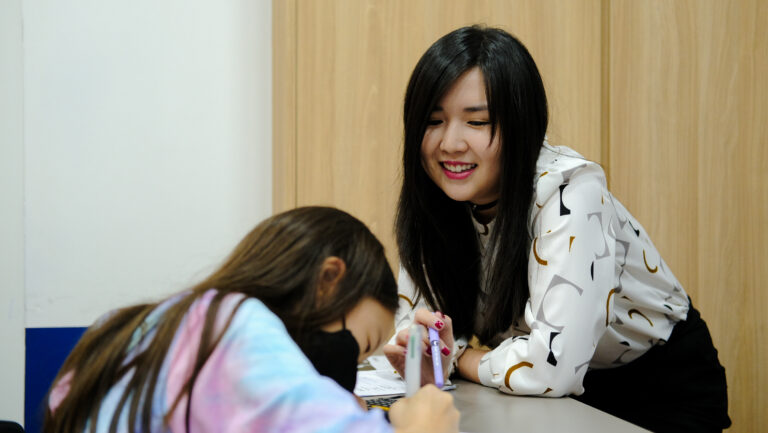The 2024 PSLE Math paper was, by most accounts, an easier one compared to previous years. But as always, success wasn’t just about knowing formulas—it was about spotting patterns, applying the right heuristics, and managing time effectively. Let’s break down the key trends that surfaced in this year’s exam and see how certain techniques would have ensured students solved the questions efficiently.
A Familiar Question Type Appeared FOUR Times
Across Paper 1 and Paper 2, one particular type of question appeared not once, not twice, but four times! This concept showed up in:
- Paper 1, Booklet A: Question 13
- Paper 2: Questions 10, 15, and 17
What did these questions test? The ability to form equations and solve area and perimeter-related problems—a classic concept, but one that required students to think critically. Let’s break them down.
Paper 1, Question 13: Area and Perimeter

In this question, students were given a key piece of information: 1 breadth and 1 length add up to 20 cm. To find the area of the rectangle, both dimensions were needed.
The diagram also provided a crucial clue: the length is 4 cm longer than the breadth. With that in mind:
Therefore, 2 breadths + 4cm = 20cm
2 breadths = 16 cm
1 breadth = 8cm
1 length = 12cm
The area of 1 rectangle is 12 cm x 8 cm, which gives us 96 cm2.
A straightforward approach for those who identified the relationships quickly!
Question 10 of Paper 2

This question tested the ability to connect different geometric properties. The key observation?
If you look at the orange line, you will see that the radius of the quarter-circle is the length of the rectangle. The question gave the perimeter of the rectangle, and that is to help us to solve for the radius of the quarter-circle.
Since the breadth of the rectangle is given, we can easily find the length of the rectangle.
1B = 24cm
2B = 48cm
2B + 2L = 118cm
48cm + 2L = 118cm
2L = 70cm
1L = 35cm
Since A and B stacked up together and C and D stacked up together are the same length, this means that if I shifted C and D upwards by 7cm, it would create the same 7cm gap at the bottom. Both blue lines in the diagram are 7cm each.
The yellow lines are the arcs of the quarter-circles. As the quarter-circles have the same radius, this means that they are the same size. When placed together, they will form a semicircle. Hence, the yellow lines together form the arc of a semicircle.
The formula for finding the arc of a semicircle is half of pi x diameter.
To find the length of the yellow lines, we take 1⁄2 × 22⁄7 × 70cm = 110cm
The perimeter of the figure is 110 + (2 × 7) + (2 × 24) + (2 × 35) = 242cm.
Question 15 of Paper 2

In this problem, two rectangular blocks (A and B) shared the same base area but had different heights. Knowing that L × B × H = Volume, and L × B = base area and their respective volumes, we can make use of the volume and base area to find the height.
To make it a bit more visual and easier to understand, block B was cut out into 2 sections such that one of them has the same height as block A, and the other block will have a height of 14 cm. You can refer to these new blocks as block 1 and block 2.
Do you then see that Block 1 and Block A have the same dimensions? They therefore have the same volume. Block 2 has a height of 14 cm. The volume of Block 2 is therefore the difference in volume between Blocks A and B.
Block 2 —> 1056 — 384 = 672cm
Base area —> 672 ÷ 14 = 48cm²
Now that we have the base area and the volume of Block A,
we can find out the height of Block A.
Height of Block A —> 384 ÷ 48 = 8cm
The height of the rectangular block is 8 + 8 + 14 = 30cm
A classic case where breaking the problem into smaller steps made all the difference.
Question 17 of Paper 2
Whenever it comes to questions that involve folding paper, we tell students that folding paper would create duplicate angles and duplicate shapes. Therefore, whatever that was cut off from the original rectangular piece of paper was 2 identical triangles that each was the size of triangle ABC.

It is important to note that line BC is 1⁄4 of line BD.
Since line BD is 4u, then BC will be 1u and line CD is 3u.
The information in the question focused on the difference in perimeter between the two shapes. To make it obvious where the additional 60cm in perimeter came from, it would be helpful to highlight identical lines in X and Y.
The brown lines are the same length. The purple lines are 50cm each. The difference in length comes from the yellow lines. In X, the yellow line is 1u long. In Y, the yellow lines add up to 7u.
Therefore, 6u = 60 cm
1u =10cm
4u = 40cm
Line BD is 40cm.
To quickly find the area of part Y, we take the area of the rectangle and minus away the 2 identical triangles that were cut out (Part X).
A Twist on the Classic Sets Question Type
This year, Question 28 in Paper 1 and Question 3 in Paper 2 featured sets and number sequences in a slightly different way.
Paper 1, Question 28: Reversed Number Pattern Question

Instead of asking for the sum of the first 131 numbers, 2024’s PSLE flipped the question: Given the sum, find the number of terms in the sequence.
As with most Sets question types, we start with the same three steps of
- Big Total / Difference
- Small Total / Difference
- No. of Sets
The big total / difference is always given in the question. In this case, the big total is 230. Based on the number sequence, the repeated pattern is 2, 0, 4, 1. This means that there are 4 digits in one set, and the sum of 1 set is 2 + 0 + 4 + 1 = 7.
How many 7s are there in 230? We always take Big Total / Small Total to find the number of sets. As you can see, there is a maximum of 32 sets, with a remainder of 6.
Since 1 set consists of 4 digits, 32 sets would consist of 32 × 4 = 128 digits. To achieve a sum of 6, we need to continue with the sequence and include 3 more digits. The digits 2 + 0 + 4 in the sequence would give us a sum of 6.
Therefore, the total number of digits would be 128 + 3 = 131.
If you add up the 1st 131 digits of the number pattern, you will get a sum of 230.
Paper 2, Question 3: LCM and Coin Count Problem

This sets question is interesting because it is not immediately apparent that you would have to find the LCM of 1 day and 7 days. Doing so would help with counting how many coins they had after 45 days.
In 7 days, Raju would have put in 21 coins and his mother would have put in 2 coins.
This means that every 7 days, there would be 23 coins added to the money box.
Again, we start with the same three steps:
- Big Total / Difference
- Small Total / Difference
- No. of sets
The big total given in the question is 45 days. In a set, we know that every 7 days, there would be 23 coins added. Since the big total given is the number of days, the small total is 7 days, and not 23 coins.
How many “7 days” do we have in a period of 45 days?
When we take the big total divided by the small total, we will see that we have a maximum of 6 sets, with a remainder of 3 days.
Since 1 set consists of 23 coins, 6 sets would consist of 6 × 23 = 138.
As for the next 3 days, Raju would have put in 3 × 3 = 9 more coins.
Since his mother only puts in 2 coins every 7 days, she wouldn’t have put in any coin in a period of 3 days.
Therefore, the total number coins in the box after 45 days would be 138 + 9 =147
Paper 1, Questions 14 and 30: Information-Heavy Problems
Two questions in Paper 1—Questions 14 and 30—stood out for the sheer amount of data they provided. The challenge? Extracting relevant details, setting up the right approach, and solving systematically.

P, Q, R are containers with the same capacity. Based on the fraction in the question, this means that each container has a capacity of 5u. Q and R were 1⁄5 filled and P was completely filled. This means that 1 and 2⁄5 containers were filled.
1 2⁄5 = 7⁄5
To have the same amount of water in each container, it will be 7⁄5 ÷ 3
When it comes to dividing fractions, students are taught to KCF (Keep-Change-Flip)
Keep the first fraction in the equation the way it is, change the division symbol to multiplication, and flip the second fraction over such that the numerator is now the denominator and the denominator is now the numerator.
After simplifying and multiplying, we will see that each container should be 7⁄15 full in the end.
Since P was initially full, and ended up being only 7⁄15 full in the end, this means that 8⁄15 of water in P was poured out.
Question 30 of Paper 1

First of all, both boards started with a different number of objects on them.
Secondly, each student pinned EITHER hearts or stars.
Thirdly, the number of hearts and stars on the boards was equal.
Since there were already 22 paper hearts on the board, after the first child sticks on 5 paper hearts, there would be 27. If the next child sticks on another 5 paper hearts, there would be 32.
Therefore, we are looking at Multiples of 5 + 22.
For the paper stars, we start off with 2 on the board. After the first child sticks on 8 paper stars, there would be 10, If the next child sticks on another 8 paper stars, there would be 18.
Therefore, we are looking at Multiples of 8 + 2.
The question stated that the number of paper hearts and paper stars was equal in the end.
After listing out a few, we see that 42 is the lowest common number between the number of stars and hearts.
In order to have 42 paper hearts on the board, 4 children stuck a total of 20 hearts.
In order to have 42 paper stars on the board, 5 children stuck a total of 40 stars.
Therefore, the number of children in the question is:
4 children who pinned hearts + 5 children who pinned stars = 9 children in total.
Final Thoughts: Why 2024’s PSLE Math Paper Was Manageable
This year’s PSLE Math paper reaffirmed a clear trend: success hinges on a strong grasp of heuristics and efficient problem-solving techniques. If students knew their heuristics concepts and applied them effectively, this year’s PSLE Math paper was actually quite manageable. The ability to quickly recognise question types and apply the right strategies made all the difference.
Moving forward, students must strengthen their conceptual understanding of area and perimeter, sets, and visualisation-based geometry questions—all of which featured prominently in this year’s exam. Additionally, mastering shortcut techniques like BCA / Equating Numerators can significantly reduce solving time for complex problem sums.
At Think Teach, we make note of these PSLE trends and drill students in questions that have been appearing frequently based on school papers as well as the PSLE of recent years. By equipping students with Shorter-Faster-Better Methods, we emphasise on question identification before guiding them to apply the most time efficient techniques to approach these questions.
Ultimately, excelling in PSLE Math isn’t about luck—it’s about strategic preparation, pattern recognition, and applying the right techniques with confidence.
If you would like for your child to learn this approach or any of the techniques mentioned, register your interest via this link: https://thinkteachacademy.com/shop/tr-fiona/



